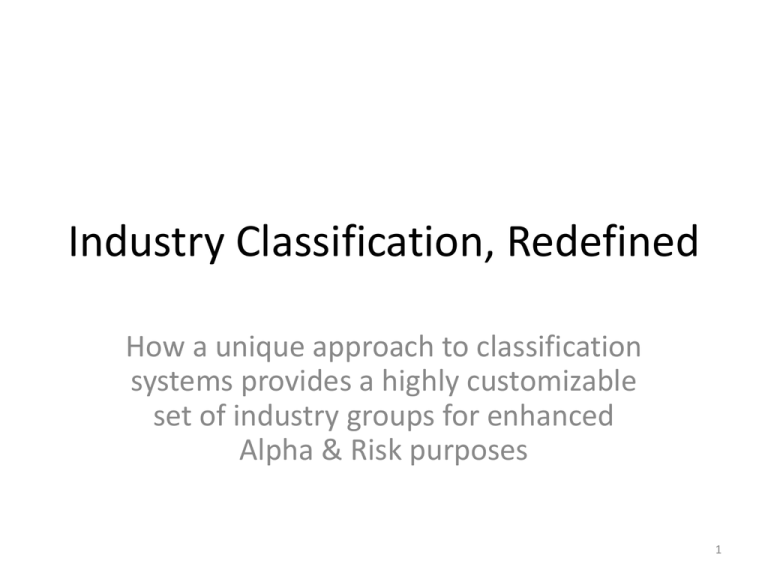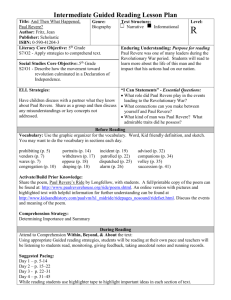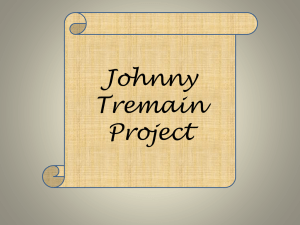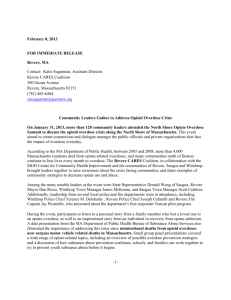Aakarsh Ramchandani
advertisement

Industry Classification, Redefined How a unique approach to classification systems provides a highly customizable set of industry groups for enhanced Alpha & Risk purposes 1 Agenda I. Traditional Classification Systems II. The Revere Approach III.Building Industry Groups IV.Comparison of Revere versus GICS 2 The 3 tenets of the “Traditional” Approach Rigidity Imposed stability, usually inaccurate Forced/Declared Lines of Business About 3-4% of companies change their Primary Line of Business How exactly is change defined traditionally? 4 Levels of Granularity Each company must be classified at the lowest industry group level. What about companies that exist in multiple sub-industry groups, but the same top level industry? 3 Mission: Lets look Map at anLinkages example… of the Capital Market Information Technology Semiconductor Equipment Semiconductor Equipment Semiconductors Convenient, but is Intel really just a semi-conductor company? 4 Lets start withof Intel’s products & services. Mission: Map Linkages the Capital Market Where do they compete? Technology Electronic Components Hardware Communication Equipment Local Area Networking Analog/Mixed Signal Semiconductors Wireless Network Adapters Specialized 802.11 based GPS IT Infrastructure Processor Radio Frequency Transmitters/Receivers Software Microprocessor (MPU) Embedded Non - Embedded Intel’s Primary Line of Business Memory Data Storage Nonvolatile Storage Administration Flash Data Availability Intel’s Product Mapping Network Network Security Access Policy Filtering 5 Revere Hierarchy™ – Agile & Granular Revere’s deep visibility into the REAL Line of Business provides a highly agile classification scheme Diversified Enterprise Niche Player Variable Depth Hierarchy Structure 6 By introducing an Arbitrary Depth Classification Scheme… … we’re redefining the creation and construction of Industry Groups 7 Building Industry Groups Number of Industry Groups Here’s what the “Raw” Tree structure looks like for the R3K…. Number of companies per Industry Group 8 A Bottom Up Approach to creating Industry Groups based off their Fundamental Lines of Business Employing a bottom-up clustering algorithm, with only 1 parameter: Number of Companies per group We take this tree structure… And flatten it into delineated Industry Groups 9 Building Industry Groups Number of Functional Groups Revere Hierarchy 7 31 86 180 349 GICS 10 24 67 160 - Level 2 Level 4 Level 6 Level 8 *Level 10 Minimum Count 60 20 10 5 Univariate Statistics of Number of Firms per Industry Group GICS2 REVERE2 GICS4 REVERE4 GICS6 REVERE6 GICS8 REVERE8 REVERE10 10 7 24 31 70 86 159 180 349 Mean 251.0 340.7 104.6 80.3 37.2 29.0 16.8 14.0 7.2 Standard Deviation 163.7 139.1 58.0 35.0 33.1 13.8 18.5 7.5 4.6 #Average Groups Per Day 10 What do the new distributions look like? Here’s a comparison of GICS to Revere Hierarchy GICS2 REVERE2 GICS4 REVERE4 GICS6 REVERE6 GICS8 REVERE8 REVERE10 11 Pooled Regression Tests, Russell 3K Annual price co-movement comparison ΔPricej,t = αt + βΔPricegroup,t + εj,t Group Name (ordered) Adj Rsqr REVERE10 REVERE8 GICS8 REVERE6 GICS6 REVERE4 GICS4 GICS2 REVERE2 Year 12 Pooled Regression Tests, Russell 3K Annualized results for Valuation Multiple/Financial Ratios Variablej,t = αt + βVariablegroup,t + εj,t Variables Tested GICS 2 REVERE 2 GICS 4 REVERE 4 GICS 6 REVERE 6 GICS 8 REVERE 8 REVERE 10 P/B 7.2% 6.7% 11.9% 12.5% 16.0% 16.3% 20.2% 22.3% 27.9% P/E 0.5% 0.5% 1.5% 2.3% 3.5% 5.2% 6.3% 9.3% 14.4% P/S 15.8% 13.5% 26.7% 29.4% 33.0% 36.1% 38.5% 43.8% 50.3% Price Return 28.4% 27.7% 30.8% 31.0% 33.8% 34.7% 37.5% 38.9% 43.6% Asset Turnover 35.5% 31.1% 46.4% 49.0% 51.5% 54.3% 60.8% 62.4% 68.7% Enterprise Value/Sales 21.0% 19.5% 44.0% 44.3% 49.1% 50.9% 54.7% 58.8% 65.8% Leverage 27.9% 26.7% 43.6% 43.9% 45.4% 50.6% 53.1% 53.4% 59.5% Profit Margin 11.1% 10.2% 14.2% 14.4% 16.5% 20.7% 21.4% 26.3% 33.4% R&D 20.2% 19.5% 27.3% 32.2% 36.0% 37.2% 37.1% 42.7% 46.6% Return On Assets 6.8% 6.9% 9.4% 10.7% 13.1% 15.4% 17.8% 20.7% 27.9% Return on Equity 6.0% 5.6% 8.5% 8.9% 12.3% 13.1% 17.0% 18.5% 24.8% 13 Basic Mean Reversion Strategy Mean Reversion Strategy Parameters 2/28/2007 to 4/30/2012 time horizon Russell 3000 Universe Market neutral, long/short quintal, monthly rebalance 1.65% 1.55% 500 Groups REVERE12? 86 Groups REVERE6 1.25% 31 Groups REVERE4 1.15% 150 Groups GICS8 67 Groups GICS6 1.05% 24 Groups GICS4 0.95% 10 Groups GICS2 7REVERE2 Groups 0.85% 0.75% 0.65% Feb-07 Jul-07 Dec-07 May-08 Oct-08 Mar-09 Aug-09 Jan-10 Jun-10 Nov-10 Apr-11 Sep-11 Feb-12 14 GICS Accumulative Return 180 Groups REVERE8 1.35% REVERE REVERE10 349 Groups 1.45% Future Research Quantified Sector Exposure, with Multi-Industry Revenue/Profit exposure Unique cluster attributes, by including supply chain & geographic revenue factors 15 Thank You Revere Data 60 East 42nd Street, Suite 716 New York, NY 10165 GlobalClientSolutions@RevereData.com (646) 350 4984 16











